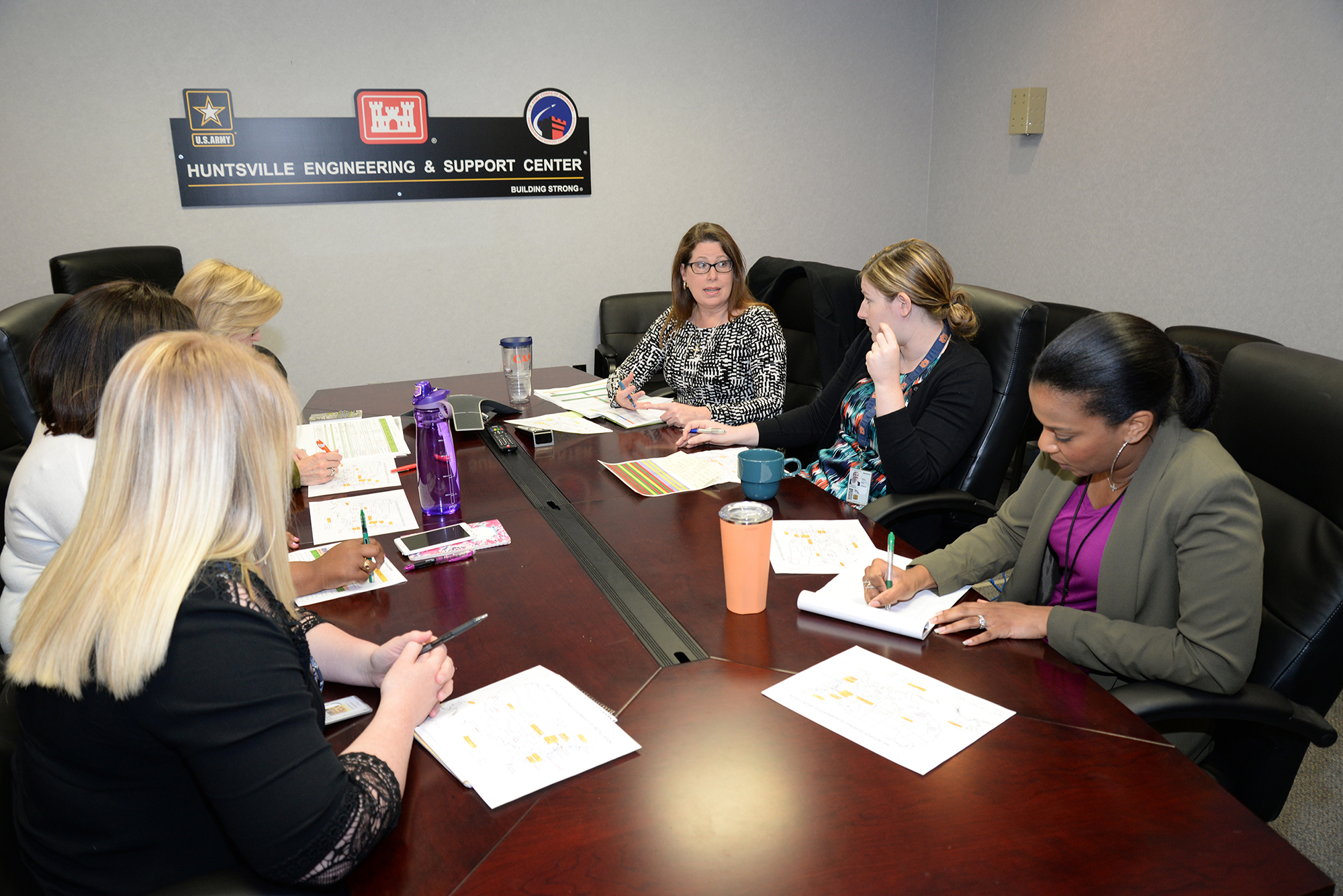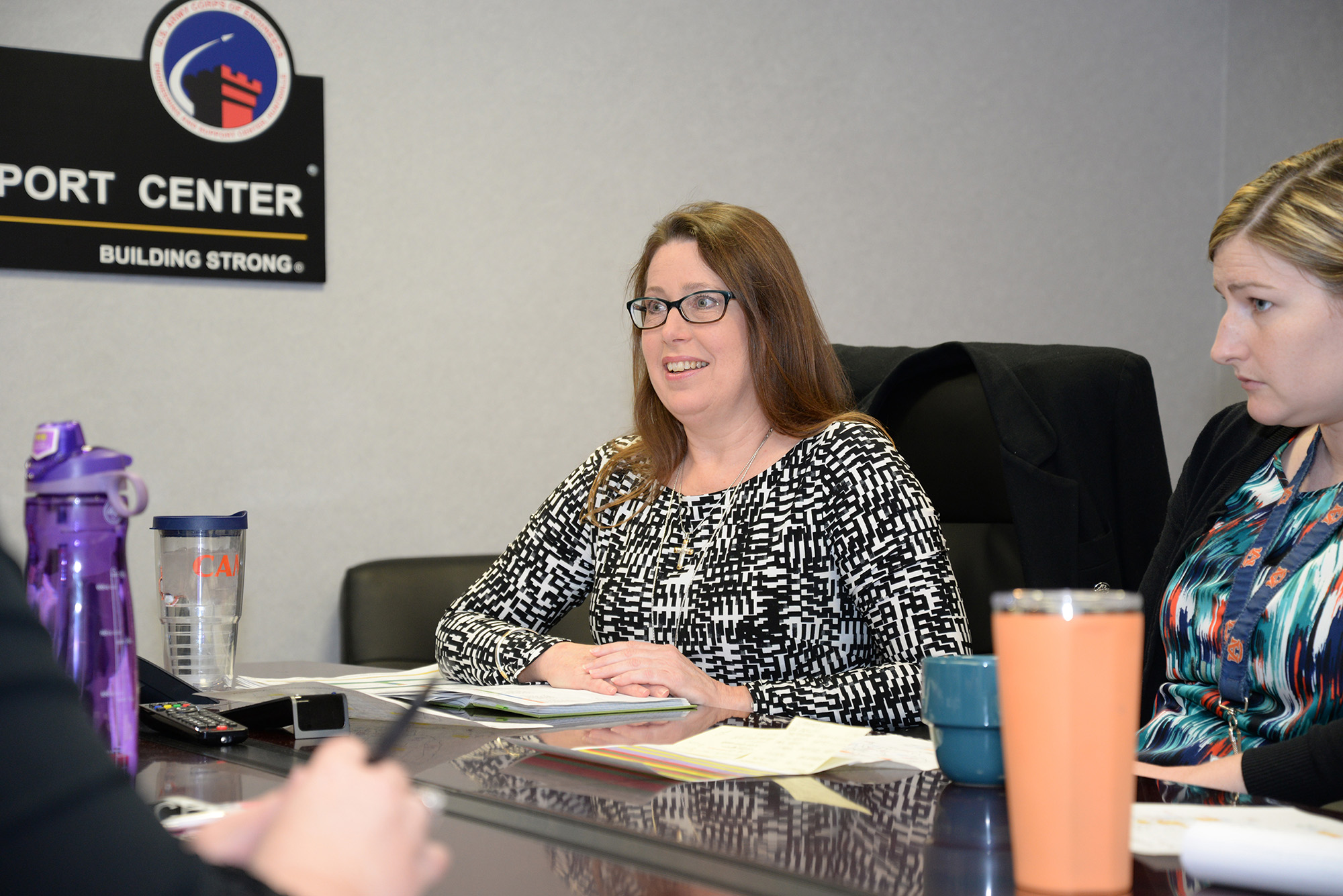
Position and Unit: Chief, Interior Design Section, U.S. Army Engineering and Support Center
Years of Service: 8
DAWIA Certification: Level III in facilities engineering
Awards: Corps of Engineers – Huntsville Center Senior Leadership Development Fellow; U.S. Army Corps of Engineers Interior Designer of the Year
Education: B.S. in building science and architecture, Auburn University
Furnishing a connection
By Susan L. Follett
Most of us have logged a few minutes at the local furniture store or spent some time wandering through the aisles of home improvement stores. But when it comes to interior design purchases, Carol Elder probably has everyone beat: As section chief for the U.S. Army Corps of Engineers (USACE) Interior Design Section, she leads a team that procures roughly $200 million in furniture and equipment each year for medical facilities—including hospitals, pharmacies and veterinary clinics—and barracks for the Army and a handful of other DOD organizations.
Elder joined USACE in Huntsville, Alabama, eight years ago, transferring from NASA’s Marshall Space Flight Center.
“This assignment has been the most rewarding and, at times, challenging assignment of my professional career,” she said. “It has provided me the unique opportunity of working alongside senior leaders to stand up a new professional discipline, interior design, at Huntsville Center, and has provided excellent opportunities for networking, collaboration, team building, career advancement and personal growth. Above all, it has given me the opportunity to serve alongside the highest-caliber facility engineering professionals in the military.”
According to Elder, the main challenge in standing up the interior design mission, an effort that began in 2010, was integrating interior design into the standard design and construction process. The Interior Design Section grew from 10 interior designers in 2010 to 27 interior designers by 2015.
“Previously, the interior design function had been performed by the architects at the Corps of Engineers – Huntsville Center. But as the unique expertise and skill sets of the professional interior designers became known, their support was requested frequently by multiple programs at Huntsville, as well as by other DOD stakeholders.”

Carol Elder, center, chief of the Interior Design Section for the U.S. Army Engineering and Support Center, Huntsville, leads a March 22 meeting with Interior Designers Lauren Ploetze and Danice Hartzog Bulls and other members of the Huntsville Center Medical Interior Design team. The group met to discuss the team’s strategy for meeting FY16 design and acquisition deadlines that support the U.S. Army Medical Command and the U.S. Army Health Facility Planning Agency/G-9. (Photo by Amy Newcomb, Public Affairs Intern)
She added, “The interior designers at Huntsville Center provide outstanding technical design and procurement support for multiple furniture acquisition programs and stakeholders, both inside and outside the United States, and also provide structural interior design services for specialized projects requested by customers and stakeholders. They’re widely recognized as subject-matter experts in their field, particularly in space planning and furniture acquisition.”
In 2014, Elder was named USACE Interior Designer of the Year for her work in managing several complex interior design projects. “I was humbled and honored to be selected,” said Elder. “It was by far the best recognition I could have received from USACE. I have a lot of gratitude, and thanks go out to my teammates and supervisors for supporting me and making it possible. There is no way I could have done this on my own—it’s because of true team effort.”
What do you do in the Army? Why is it important?
I lead a team of interior designers in medical interior design and barracks interior design for multiple DOD stakeholders, including the Defense Health Agency, U.S. Army Medical Command, the Army Health Facility Planning Agency/G-9, U.S. Army Installation Management Command Headquarters and the Army’s assistant chief of staff for installation management, as well as the Navy and the Air Force. Interior design support and services include structural interior design for military construction; and sustainment, restoration and modernization for medical and military facilities, as well as design for furniture, fixtures and equipment and interior design and acquisition for military construction; and interior upgrades for medical and military facilities.
In layman’s terms, I would describe my job as a strategic planner, coordinator, facilitator, collaborator—a connector, in other words—to support the interior designers, the project delivery team (PDT) environment and our customers and stakeholders to ensure their mission, and ours, is completed successfully with expectations delivered on time and within budget.
What initially attracted you to working with USACE?
Before joining USACE, I was an architect for NASA at the Marshall Space Flight Center, supporting the Facilities Engineering Directorate. My career focus, professional experience and passion for facility planning, design and construction were a good fit with the mission and core values of USACE. Having many years of experience supporting NASA with the planning, budgeting, design, construction and management of federal facilities with unique and specialized mission requirements, I felt that my professional knowledge and experience would be beneficial to USACE and that USACE would offer exciting and challenging opportunities for my career growth and advancement.

Carol Elder, chief of the Interior Design Section for the U.S. Army Engineering and Support Center, Huntsville, meets with Interior Designer Lauren Ploetze and other members of the Huntsville Center Medical Interior Design team. Elder played a key role in standing up the interior design mission, an effort that began in 2010. (Photo by Amy Newcomb, Public Affairs Intern, U.S. Army Engineering and Support Center, Huntsville)
What’s the most important skill or attribute for doing your job well?
Communication, without a doubt. Being able to communicate technical requirements, project solutions, and vision across the PDT—internal and external—is essential for team and technical success.
You played a part in standing up the new professional discipline of interior design at Huntsville. What were the rewards of that work? What advice would you give to others about to handle a similar task?
The most rewarding part of this assignment has been to have the honor to work with these outstanding design professionals to build a highly competent, motivated interior design team and to recognize the accomplishments that their passion, leadership and diversity have contributed to the thousands of successful projects and mission successes.
The best advice that I can offer to others when supporting a similar task is to recognize the unique talents within each individual that brought this function together, to form a strong team, to provide opportunities for growth and leadership within the team, and to empower team members with the resources and expertise they need to become ambassadors of their design discipline and mission to co-workers, PDT members, customers and stakeholders.
“Faces of the Force” is an online series highlighting members of the Army Acquisition Workforce through the power of individual stories. Profiles are produced by the U.S. Army Acquisition Support Center Communication and Support Branch, working closely with public affairs officers to feature Soldiers and civilians serving in a variety of AL&T disciplines. For more information, or to nominate someone, please contact 703-805-1006.
Subscribe to Army AL&T News, the premier online news source for the Acquisition, Logistics, and Technology (AL&T) Workforce.







